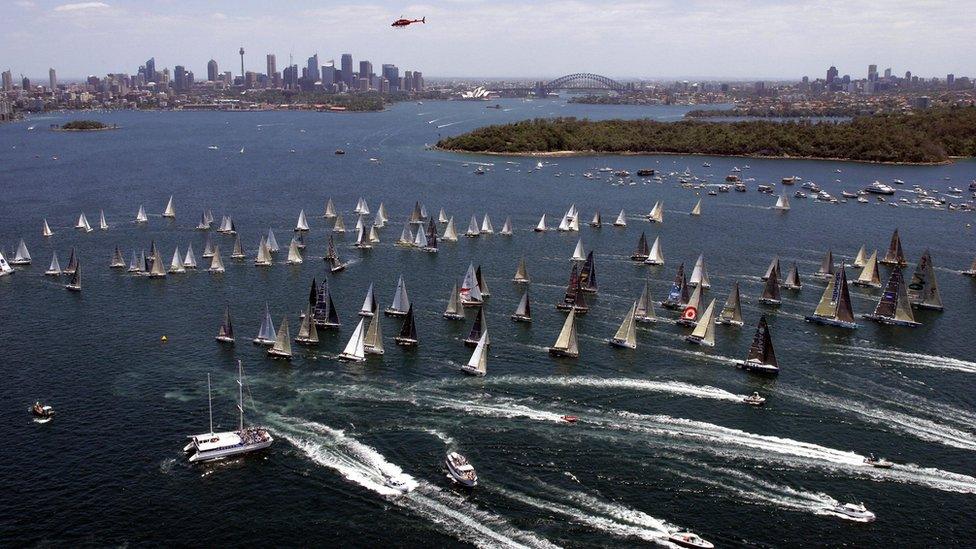The gruelling test of the Sydney to Hobart yacht race
- Published

Australia's famous yacht race begins in Sydney Harbour on Boxing Day
Waves of adrenalin, bone-aching exhaustion and the ever-present risk of calamity. These are the key ingredients to one of the world's great ocean classics - the Sydney to Hobart yacht race, a 630 nautical mile (1,166km) dash down eastern Australia that starts on Boxing Day.
A record number of foreign boats have entered this year, including five from Asia, along with others from Germany, Russia, the United States and New Zealand.
Britain's sole representative is Richard Stain, a former businessman from Cheshire, who bought the yacht Samskara specifically to race from Sydney to Hobart. He has never competed in the famous blue-water blockbuster, telling the BBC he is keen to avoid a stomach-churning ride.
"I do suffer a little bit from seasickness, so I'm just hoping that I'm not going to be seasick because I know what it's like. If you get it bad it can just knock you out," he says.
'Hanging on wherever you can'
Mr Stain's crew includes a Dutchman, an Australian and a Welsh lobster fisherman, who is the navigator.
At race HQ at the Cruising Yacht Club of Australia in upmarket Darling Point, Mr Stain clambers down a narrow companionway, where below deck Samskara seems surprisingly spacious and comfortable. But he says it can be a hellish place to be.
"This could be absolutely horrible down here," he explains. "If it is heavy weather and the boat is leaning over at 45 degrees this could be pretty awful. You'll be hanging on wherever you can."

Former businessman Richard Stain is Britain's sole participant in the race
There have been hair-raising moments even before the fleet gathers for the start in Sydney, an occasion that has become one of the greatest spectacles in Australian sport.
One of the favourites, the super maxi Scallywag, had a nail-biting near-miss during a warm-up event when it somehow managed to avoid colliding with a small spectator ferry and another vessel. Disaster was only averted by the deft hands of the skipper David Witt, who guided the 30m craft through the tightly grouped obstacles to safety.
"The maritime boat, we thought, would have moved and didn't, and left us with little choice but to thread the needle," says Seng Huang Lee, a Malaysian-born businessman who is based in Hong Kong.
"Not many skippers in the world can do that and David's one of them and I'm glad to have him on the team." Earlier this year Mr Lee bought the yacht Ragamuffin, and renamed it Scallywag.
Finish line a challenge
There are a record-breaking five Asian boats in this year's line-up, and Mr Lee believes sailing is rapidly growing in popularity.
"I think it is definitely taking off," he says. "It will take a bit of time but it is a very nascent sport. You can see the growing interest, especially out in China and South East Asia, and hopefully a team like Scallywag could create more interest and awareness in the sport."
Last year Ark 323 became mainland China's first entry in this famous Australian competition that began in 1945. Its race, however, was short-lived after it was forced to retire with damage to its hull. But the all-Chinese crew is back and determined to cross the finishing line in the Tasmanian state capital.

The crew of Ark 323 is determined to finish this year
"This is the most famous ocean race in the world and when we set up this club we have been thinking about participating in this race," says Kevin Zhou, the chief executive of the Shanghai-based Noahs Sailing Club, who will be aboard Ark 323.
Like the sea, this has been a year of highs and lows for Shane Phillips, from the Tribal Warrior Association that helps teach Indigenous people to sail. An Aboriginal crew had been practising onboard the yacht Kayle, which is owned by Sailors With Disabilities.
It struck a large rock ledge in Sydney Harbour and could not be repaired in time for the starter's klaxon on 26 December.
Safety comes first
But Mr Phillips and his colleagues will be on another yacht heading to Hobart as part of a training exercise for next year's competition, and although not officially part of the main event, they have steeled themselves for what lies ahead.
"We're expecting the worst. We're thinking best to prepare ourselves for the worst-case scenario and be safety conscious," he says.
"There are going to be times when we're going to be out of our depth. We are probably the equivalent of the Jamaican bobsled team."
No Aboriginal crew has ever competed in the dash to the Apple Isle.

Some 91 boats will compete in the 630 nautical mile (1166km) race
When the 91 boats leave Sydney they will face a journey into the unknown. Conditions down eastern Australia and across Bass Strait, which separates Tasmania from the mainland, can be brutal and unpredictable. In 1998, six sailors died when a wild storm battered the fleet.
Australia's Bureau of Meteorology has predicted that "fresh to strong north-easterly winds" will give the yachts a flying start on Boxing Day, which could give the powerful super maxis every chance of beating the current race record of one day, 18 hours and 23 minutes.